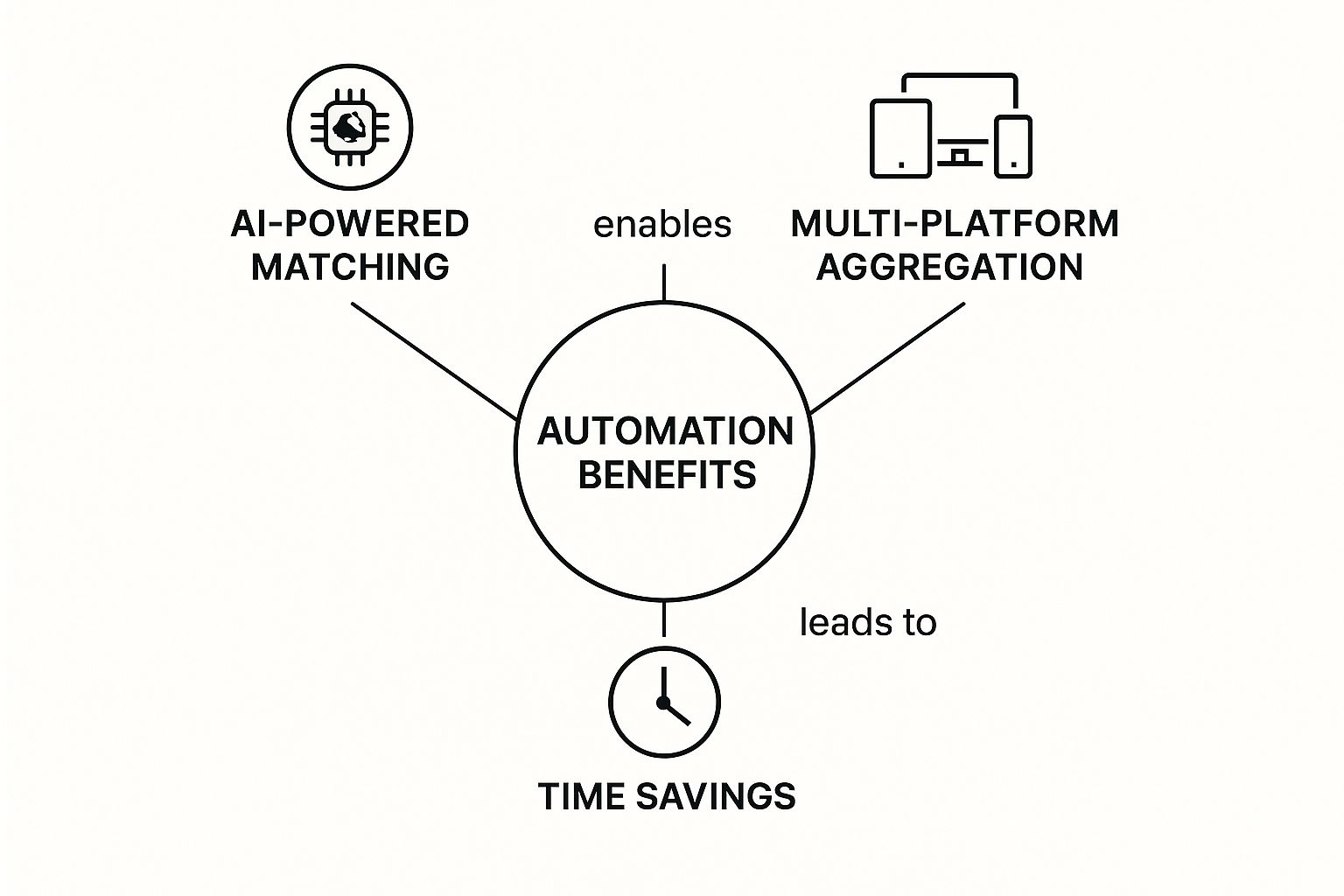The talent landscape of today demands more than just posting a job and waiting. Proactive talent acquisition is now the cornerstone of building a competitive team, and this is where mastering the art and science of sourcing in the recruitment process becomes critical. It's the strategic practice of actively identifying, engaging, and nurturing potential candidates, often targeting those who aren't even looking for a new role.
This guide moves beyond theory to provide a deep, practical dive into seven essential sourcing strategies and platforms. We will explore specific use cases, honest limitations, and implementation guidance for each resource. To truly move beyond traditional methods and unlock future talent, it's essential to understand how to effectively build a robust talent pipeline that fuels your organization's growth. From leveraging massive professional networks like LinkedIn to harnessing the power of AI-driven automation, these are the resources you need to find the right people before your competitors do. We'll give you the actionable insights needed to transform your approach, moving from a passive "post and pray" method to a strategic, proactive talent acquisition engine.
1. LinkedIn Recruiter
LinkedIn Recruiter is the undisputed titan in the world of professional talent acquisition, serving as the premium sourcing platform built upon LinkedIn's massive global network of over one billion professionals. It moves beyond the standard LinkedIn experience, providing recruiters with a powerful suite of tools designed specifically for an effective sourcing in recruitment process. This includes advanced search filters, access to full profiles of members outside your network, and dedicated project pipelines for candidate management.

Unlike basic keyword searching, Recruiter allows sourcers to build complex search strings using Boolean logic and over 40 advanced filters, including years of experience, company size, and specific skills. This precision enables the identification of passive candidates who are not actively applying for jobs but possess the exact qualifications required.
When and Why to Use LinkedIn Recruiter
This platform is most effective when you need to fill specialized, mid-to-senior level, or hard-to-fill roles where the candidate pool is limited. It is the go-to tool for proactive sourcing rather than reactive applicant screening. For example, a tech startup seeking a Senior AI Engineer with experience in natural language processing would use Recruiter to pinpoint individuals at competitor companies, even if they aren't looking for a new job.
Companies like Microsoft, which fills over 50,000 positions annually, and Salesforce, which reduced its time-to-fill by 30%, rely heavily on LinkedIn Recruiter's capabilities to build and nurture talent pipelines.
Actionable Tips for Implementation
To maximize your success with LinkedIn Recruiter, move beyond basic searches and integrate these advanced tactics:
- Master Boolean Search: Combine keywords with operators like AND, OR, and NOT (e.g., "Java" AND "Spring" NOT "Intern") to dramatically narrow down your results to the most relevant profiles.
- Personalize InMail: Avoid generic templates. Reference a candidate's recent post, a shared connection, or a specific project mentioned on their profile to increase your response rate significantly.
- Leverage Project Pipelines: Use the platform's project management features to track candidates through your sourcing funnel, add notes, and collaborate with your hiring team directly within the tool.
- Set Up Search Alerts: Save your complex search queries and activate alerts. LinkedIn will then automatically notify you when new profiles match your criteria, ensuring a continuous flow of potential candidates.
2. GitHub for Developer Sourcing
GitHub stands as the world's largest code repository and developer community, making it a goldmine for technical recruiters. It provides a unique lens into a developer's capabilities, moving beyond resumes to showcase actual work product. A key part of a modern sourcing in recruitment process for tech roles, it allows sourcers to analyze a candidate's code contributions, project involvement, and preferred programming languages to verify skills and passion for their craft.

Unlike traditional platforms, GitHub offers tangible proof of expertise. Recruiters can assess the quality of code, documentation practices, and collaboration on open-source projects. This data-driven approach allows for the identification of top-tier talent, including passive candidates who are deeply engaged in their work but not actively job hunting.
When and Why to Use GitHub
This platform is indispensable when sourcing for highly specialized technical roles like software engineers, data scientists, and machine learning specialists. It is the ideal tool for verifying technical proficiency and finding individuals who are passionate contributors to the developer community. For instance, a company like Shopify looking for an expert Ruby developer can directly source candidates by identifying top contributors to popular Ruby gems, ensuring they find someone with proven, community-vetted skills.
Tech giants like Google and Microsoft regularly source talent by identifying key contributors to major open-source projects. Netflix has successfully recruited machine learning engineers by analyzing their public repositories and projects on the platform.
Actionable Tips for Implementation
To effectively leverage GitHub for sourcing, you must go beyond simply viewing profiles and adopt a more analytical approach:
- Search Strategically: Use GitHub's advanced search to filter developers by programming language, location, and number of followers (e.g.,
language:python location:berlin followers:>50). - Analyze Contribution History: Look for consistent contribution patterns over time, not just a single burst of activity. This "commit graph" indicates dedication and ongoing engagement.
- Examine Code Quality: Review a candidate's repositories to assess code clarity, structure, and documentation. This provides direct insight into their work standards and attention to detail.
- Cross-Reference Profiles: Since GitHub doesn't always have direct contact information, use the username or full name to find the candidate's profile on LinkedIn or other social platforms to initiate contact.
3. Boolean Search Techniques
Boolean search is not a tool but a foundational methodology that supercharges nearly every sourcing platform, from Google and LinkedIn to specialized applicant tracking systems. It is the art and science of using logical operators (AND, OR, NOT) and modifiers like parentheses and quotation marks to build highly specific search queries. This technique transforms a simple keyword search into a powerful tool for an effective sourcing in recruitment process, allowing recruiters to precisely define, broaden, or exclude criteria to uncover hidden talent.
Instead of just searching for "project manager," a sourcer can construct a string like ("project manager" OR "program manager") AND (agile OR scrum) AND PMP NOT "entry-level". This precision filters out irrelevant candidates and hones in on profiles that meet multiple, specific requirements, dramatically improving the quality of the initial talent pool. This approach is a cornerstone of modern sourcing, turning vast databases into manageable, high-relevance candidate lists.
When and Why to Use Boolean Search Techniques
Boolean search is indispensable when sourcing for roles with very specific skill combinations, niche technologies, or geographical constraints. It is the primary method for uncovering passive candidates across the open web, beyond the confines of a single platform. For instance, a recruiter at Amazon could use a complex Boolean string on Google to find AWS-certified professionals with security clearance who have profiles on sites like GitHub or Stack Overflow, not just LinkedIn. It is the go-to strategy for high-volume or highly specialized sourcing efforts.
Sourcing pioneers like Glen Cathey have demonstrated that mastering Boolean logic can reduce search time by over 50% while simultaneously increasing the relevancy of candidate matches, proving it to be a critical skill for any serious recruiter.
Actionable Tips for Implementation
To effectively integrate Boolean search into your workflow, focus on building and refining your queries strategically:
- Start Simple, Build Complexity: Begin with a core query (e.g.,
"software engineer" AND "Python") and incrementally add layers of criteria with operators like OR for synonyms and NOT for exclusions. - Use Parentheses for Order: Group related terms with parentheses to control the search logic. For example,
(Java OR Python) AND ("cloud" OR AWS)ensures the engine searches for either language combined with either cloud technology. - Test Across Platforms: Be aware that syntax can differ slightly between Google, LinkedIn, and your ATS. Test and adapt your strings for each platform to ensure optimal results.
- Save Your Winning Strings: Keep a repository of your most effective search strings for recurring roles. This saves time and standardizes the quality of your sourcing efforts for similar positions in the future.
4. AngelList (Wellfound) for Startup Talent
AngelList, now rebranded as Wellfound, is the definitive talent marketplace for the startup ecosystem. It goes beyond a typical job board, creating a specialized environment where innovative companies connect with ambitious professionals who are specifically seeking high-impact roles, often in exchange for equity. This focus makes it an indispensable tool for an effective sourcing in recruitment process within the tech and startup worlds.
Unlike broad-based platforms, Wellfound profiles are rich with startup-centric data, such as a candidate's interest in company stage, desired equity/salary mix, and experience with specific tech stacks common in new ventures. This allows sourcers to identify and engage talent that is already culturally and financially aligned with startup realities, dramatically reducing sourcing friction.
When and Why to Use AngelList (Wellfound)
This platform is the gold standard for early-stage to mid-stage startups (Seed to Series C) looking to hire their foundational technical and product teams. It's particularly powerful for finding engineers, designers, product managers, and marketers who are passionate about building things from the ground up. For example, a fintech startup needing its first blockchain developer would use Wellfound’s crypto-specific filters to find candidates with relevant, verifiable experience.
Tech giants like Stripe and Coinbase built their early core teams by sourcing talent directly from AngelList, leveraging its concentrated pool of candidates who were actively seeking the risk and reward of a startup environment.
Actionable Tips for Implementation
To stand out in Wellfound's competitive landscape, your sourcing strategy must be tailored to the startup mindset:
- Highlight Equity and Impact: Lead with the upside. Clearly articulate the potential for growth and the significance of the candidate’s role in the company's journey, as this is a primary motivator for this audience.
- Be Transparent About Your Stage: Clearly state your funding stage, team size, and runway. Top startup talent values transparency and wants to make an informed decision about the risk they are taking on.
- Use Startup-Specific Language: Ditch the corporate jargon. Communicate your mission, vision, and culture using authentic, direct language that resonates with builders and innovators.
- Filter for Similar-Stage Interest: Use the platform’s filters to target candidates who have expressed interest in or previously worked at companies of a similar size and stage to yours, ensuring better alignment.
5. Twitter/X Advanced Search for Real-time Sourcing
Beyond professional networks, Twitter/X offers a dynamic, real-time pulse of industry conversations, making its advanced search an unconventional yet powerful tool for an effective sourcing in recruitment process. Instead of relying on static profiles, sourcers can identify top talent through their demonstrated expertise, active participation in discussions, and thought leadership within their fields. This method provides unfiltered insight into a candidate's passion, communication style, and up-to-the-minute interests.
Twitter's advanced search allows recruiters to filter conversations by specific keywords, hashtags, user mentions, and even geographic locations. This enables the discovery of passive candidates who are actively contributing to industry-specific dialogues, such as a software developer live-tweeting a tech conference or a marketing strategist sharing insights on a new campaign trend.
When and Why to Use Twitter/X Advanced Search
This platform is ideal for sourcing roles in fast-moving industries like tech, marketing, and media, where active community engagement is a strong indicator of expertise and passion. It's particularly effective for identifying emerging talent and thought leaders before they are widely known. For instance, a startup could monitor conversations around a new programming language on #DevTwitter to find early adopters and highly engaged developers who might be open to innovative opportunities.
Tech giants like IBM have successfully used Twitter to recruit AI researchers by following #MachineLearning conversations, while countless marketing agencies have discovered top-tier talent by engaging with professionals in #MarketingTwitter discussions.
Actionable Tips for Implementation
To transform Twitter/X from a social network into a sourcing engine, apply these targeted strategies:
- Monitor Industry Hashtags: Follow and engage with niche hashtags relevant to your open roles (e.g., #FinTech, #UXdesign, #GrowthHacking) to find active professionals.
- Create Private Twitter Lists: Once you identify potential candidates, add them to a private list. This creates a curated timeline, allowing you to track their activity and find the right moment to engage without publicly following them.
- Engage Authentically First: Before sending a direct message, interact with a candidate's content. Reply to a tweet or share their post to build rapport and demonstrate genuine interest in their work.
- Leverage Conference & Event Hashtags: During major industry events, monitor the official hashtag to identify attendees and speakers who are key players and passionate professionals in your target field.
6. Stack Overflow for Technical Talent
Stack Overflow is far more than a Q&A site; it's the world’s largest and most trusted online community for developers. For recruiters, it represents a unique sourcing channel where technical expertise is demonstrated, not just claimed. This platform offers a direct view into how candidates think, problem-solve, and communicate about complex technical challenges, making it an invaluable tool for an evidence-based sourcing in recruitment process. Instead of relying on a resume, you can see a developer's skills in action.
The platform allows sourcers to identify top talent based on their contributions within specific technology tags (e.g., Python, Kubernetes, TensorFlow). A developer’s reputation score, earned badges, and the quality of their answers provide concrete evidence of their proficiency and their standing within the developer community.
When and Why to Use Stack Overflow
This platform is indispensable when sourcing for highly specialized or senior technical roles where practical coding knowledge and problem-solving ability are paramount. It is the ideal place to find passive candidates who are deeply engaged in their craft but may not be actively browsing job boards. For instance, a financial services company looking for a fintech developer with expertise in a niche financial API can search for developers consistently answering questions with that specific tag.
Companies like Microsoft and Google regularly use Stack Overflow to identify and engage with experts in their respective technologies, such as Azure and Android, by observing high-quality contributions in those specific areas.
Actionable Tips for Implementation
To effectively use Stack Overflow for sourcing, you must approach it as a community member, not just a recruiter:
- Search by Technology Tags: Focus your search on the specific programming languages, frameworks, or tools relevant to your open role (e.g., "rust," "react-native," "azure-devops").
- Evaluate Contribution Quality: Don't just look at reputation scores. Read the answers a candidate provides. Are they clear, well-researched, and respected by the community? This reveals their communication and collaboration skills.
- Look for Consistent Engagement: A long history of consistent, high-quality contributions is a stronger indicator of deep expertise than a few recent, popular answers.
- Cross-Reference with GitHub: Use a candidate's Stack Overflow profile to find their GitHub account. This provides a complete picture, combining their community contributions with their personal project portfolio.
7. Sourcing Automation Tools (HiringSolved, Hiretual, SeekOut)
Sourcing automation tools are AI-powered platforms that revolutionize the sourcing in recruitment process by aggregating candidate data from dozens of sources, automating search functions, and providing intelligent recommendations. Platforms like HiringSolved, Hiretual, and SeekOut comb through social networks, professional sites, and public databases to build rich, comprehensive candidate profiles, significantly reducing manual effort and expanding the accessible talent pool.
These tools go beyond simple keyword matching, using AI to understand context, infer skills, and identify best-fit candidates that traditional methods might miss. They provide recruiters with verified contact information, diversity analytics, and powerful engagement features, all within a single interface that streamlines the entire sourcing workflow from discovery to outreach.
The infographic below illustrates the core benefits driven by these automation platforms.

The visualization highlights how the aggregation of diverse data sources and AI-driven matching directly lead to significant time savings, which is the primary value proposition of these tools.
When and Why to Use Sourcing Automation Tools
These platforms are indispensable for high-volume recruitment or when sourcing for roles with highly competitive and niche skill sets, such as in tech and engineering. They are most powerful when a company needs to scale its hiring efforts quickly without a proportional increase in headcount. For example, a global enterprise like Amazon uses these tools to manage its massive campus and experienced hire sourcing campaigns efficiently.
Leading companies have seen dramatic results. Salesforce, for instance, used automation to cut its manual sourcing time by 60%, while Uber leverages SeekOut to meet specific diversity goals in its engineering recruitment, demonstrating the strategic impact of these platforms.
Actionable Tips for Implementation
To effectively integrate sourcing automation, a strategic approach is necessary. For more information, you can learn about data-driven decision making at ziloservices.com.
- Start with Clear Profiles: Define your ideal candidate profile with specific skills, experiences, and attributes. This provides the AI with a clear target to optimize its search and matching algorithms.
- Combine Automation with Personalization: Use the tool to identify top candidates quickly, but always follow up with personalized, human-centric outreach to improve engagement and response rates.
- Train Your Team: Ensure your recruiters are fully trained on the platform’s specific features, such as its diversity filters or advanced Boolean logic, to unlock its full potential.
- Measure and Refine: Regularly monitor key metrics like time-to-fill and quality of hire to measure the tool's ROI. Use this data to continually refine your search parameters and strategies.
Top 7 Recruitment Sourcing Tools Comparison
| Platform/Technique | Core Features/Unique Selling Points ✨ | User Experience/Quality ★★★★☆ | Value Proposition 💰 | Target Audience 👥 | Price Points 💰 |
|---|---|---|---|---|---|
| LinkedIn Recruiter | Advanced Boolean search, InMail, ATS integration, pipeline mgmt ✨ | Extensive candidate insights, mobile access ★★★★☆ | Premium global reach, high response rate 🏆 | Corporate recruiters, diverse industries 👥 | $140-200+/month 💰 |
| GitHub for Developer Sourcing | Public repos, contribution graphs, code skill evaluation ✨ | Real work showcased, free access ★★★★☆ | Assess real coding skills, global dev reach 🏆 | Technical recruiters, dev roles 👥 | Free (public profiles) 💰 |
| Boolean Search Techniques | AND/OR/NOT operators, phrase matching, customizable queries ✨ | Precise, platform-agnostic, skilled use needed ★★★★☆ | Cost-effective, scalable across industries | All recruiters, sourcing experts 👥 | Free (skill-based) 💰 |
| AngelList (Wellfound) for Startups | Startup-focused profiles, equity transparency, funding info ✨ | Startup-centric, role assessments ★★★☆☆ | Access to pre-qualified startup candidates | Startup recruiters, early-stage companies 👥 | Freemium, some paid features 💰 |
| Twitter/X Advanced Search | Real-time monitoring, hashtags, filters, engagement metrics ✨ | Real-time insights, influencer ID ★★★☆☆ | Free, shows personality and expertise | Recruiters seeking active industry voices 👥 | Free |
| Stack Overflow for Technical Talent | Reputation scores, tech tags, developer story, Talent platform ✨ | Deep expertise insight, community validation ★★★★☆ | Evaluate problem-solving skills, niche talent pool | Tech recruiters, developer roles 👥 | Some paid (Talent service) 💰 |
| Sourcing Automation Tools | AI matching, multi-source aggregation, Boolean automation ✨ | Time-saving, scalable, data-dependent ★★★☆☆ | AI-driven efficiency, comprehensive profiles 🏆 | Enterprise recruiters, high-volume hiring 👥 | $200-500+/month 💰 |
Building a Modern, Proactive Sourcing Engine
The journey through the modern landscape of sourcing in the recruitment process reveals a fundamental truth: success is no longer about simply posting a job and waiting. It’s about building a dynamic, multi-channel engine for proactive talent discovery. We've explored a powerful arsenal of tools and techniques, from the professional networking behemoth of LinkedIn Recruiter to the niche, code-centric communities on GitHub and Stack Overflow. We delved into the art and science of Boolean search, the startup-focused ecosystem of AngelList (Wellfound), and even the real-time pulse of conversations on Twitter/X.
The most critical takeaway is that these platforms are not mutually exclusive. An elite sourcing strategy is a blended one. It involves weaving together the broad reach of mainstream networks with the deep specialization of technical forums. It’s about leveraging the efficiency of automation tools like SeekOut or Hiretual to identify potential candidates at scale, while simultaneously applying the human touch of personalized, insightful outreach to convert them into engaged applicants. This strategic integration transforms sourcing from a reactive, transactional task into a continuous, relationship-building function that fuels your talent pipeline.
Your Actionable Blueprint for Sourcing Excellence
To translate these insights into action, your focus should be on creating a sustainable and adaptable sourcing framework. Start by auditing your current processes. Which channels yield the highest quality candidates for your most critical roles? Where are the gaps?
- Master the Fundamentals: Dedicate time to mastering advanced Boolean logic. This is the foundational skill that elevates your effectiveness across nearly every sourcing platform.
- Specialize Your Approach: Don’t use a one-size-fits-all strategy. Sourcing a Senior Backend Developer requires a different approach than finding a Product Manager. For technical roles, focusing on platforms like GitHub is crucial. For more comprehensive guidance, exploring proven strategies for recruiting software engineers can provide deeper insights into the nuances of tech hiring.
- Embrace a Data-Informed Mindset: Track your metrics relentlessly. Monitor your outreach-to-response rates, the conversion rates from sourced candidates to hires, and the overall time-to-fill for roles filled via sourcing. This data is your guide to optimizing your efforts and proving the ROI of your sourcing function.
Ultimately, mastering the sourcing in the recruitment process is what separates high-growth, innovative organizations from the rest. It is a strategic imperative that directly impacts your ability to hire the talent needed to achieve your business goals. By building a proactive, intelligent, and human-centric sourcing engine, you are not just filling roles; you are building the future of your company, one exceptional candidate at a time.
Ready to augment your team's sourcing capabilities with expertly vetted talent and AI-powered data services? Zilo AI provides the skilled human resources and high-quality data annotation required to scale your most ambitious projects in retail, BFSI, and healthcare. Discover how our talent solutions can become your strategic advantage at Zilo AI.

